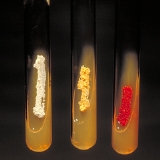
Nocardia
Overview
Genus
In biology, a genus is a low-level taxonomic rank used in the biological classification of living and fossil organisms, which is an example of definition by genus and differentia...
of weakly staining Gram-positive
Gram-positive
Gram-positive bacteria are those that are stained dark blue or violet by Gram staining. This is in contrast to Gram-negative bacteria, which cannot retain the crystal violet stain, instead taking up the counterstain and appearing red or pink...
, catalase-positive
Catalase
Catalase is a common enzyme found in nearly all living organisms that are exposed to oxygen, where it catalyzes the decomposition of hydrogen peroxide to water and oxygen...
, rod-shaped bacteria
Bacteria
Bacteria are a large domain of prokaryotic microorganisms. Typically a few micrometres in length, bacteria have a wide range of shapes, ranging from spheres to rods and spirals...
. It forms partially acid-fast
Acid-fast
Acid-fastness is a physical property of certain bacteria, specifically their resistance to decolorization by acids during staining procedures.Acid-fast organisms are difficult to characterize using standard microbiological techniques Acid-fastness is a physical property of certain bacteria,...
beaded branching filaments (acting as fungi, but being truly bacteria). It has a total of 85 species. Some species are non-pathogenic while others are responsible for nocardiosis
Nocardiosis
Nocardiosis is an infectious disease affecting either the lungs or the whole body . It is due to infection by bacterium of the genus Nocardia, most commonly Nocardia asteroides or Nocardia brasiliensis.It is most common in men, especially those with a compromised immune system...
. Nocardia are found worldwide in soil that is rich with organic matter. In addition, Nocardia are oral microflora found in healthy gingiva as well as periodontal pockets.

